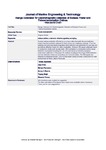Range Extension for Electromagnetic Detection of Subsea Power and Telecommunication Cables
| dc.contributor.author | Szyrowski, T | |
| dc.contributor.author | Khan, Asiya | |
| dc.contributor.author | Pemberton, Richard | |
| dc.contributor.author | sharma, sanjay | |
| dc.contributor.author | Singh, Y | |
| dc.contributor.author | Polvara, R | |
| dc.date.accessioned | 2018-09-06T10:24:09Z | |
| dc.date.issued | 2019-07-01 | |
| dc.identifier.issn | 2046-4177 | |
| dc.identifier.issn | 2056-8487 | |
| dc.identifier.uri | http://hdl.handle.net/10026.1/12232 | |
| dc.description.abstract |
Subsea cables protection afforded by burying a cable [beneath the sea bed] also means that the available methods for their survey are drastically reduced. From the existing methods only electromagnetics (EM) detection can penetrate the sea bed and provide an effective means for cable localisation. However, EM waves attenuate faster in conductive media such as sea water. EM localisation is considered a short range detection mechanism requiring the use of autonomous or remotely operated underwater platforms. In this paper, the authors investigate the range of EM detection and test detection distances exceeding one hundred metres. The EM signal was detected at distances around 140 m in sea water during the trials conducted in a ‘real’ environment at Hooe Lake in Plymouth. | |
| dc.format.extent | 65-72 | |
| dc.language | en | |
| dc.language.iso | en | |
| dc.publisher | Taylor & Francis (Routledge) | |
| dc.title | Range Extension for Electromagnetic Detection of Subsea Power and Telecommunication Cables | |
| dc.type | journal-article | |
| dc.type | Journal Article | |
| plymouth.author-url | https://www.webofscience.com/api/gateway?GWVersion=2&SrcApp=PARTNER_APP&SrcAuth=LinksAMR&KeyUT=WOS:000856131400001&DestLinkType=FullRecord&DestApp=ALL_WOS&UsrCustomerID=11bb513d99f797142bcfeffcc58ea008 | |
| plymouth.issue | 2 | |
| plymouth.volume | 21 | |
| plymouth.publication-status | Published | |
| plymouth.journal | Journal of Marine Engineering and Technology | |
| dc.identifier.doi | 10.1080/20464177.2019.1634966 | |
| plymouth.organisational-group | /Plymouth | |
| plymouth.organisational-group | /Plymouth/Faculty of Science and Engineering | |
| plymouth.organisational-group | /Plymouth/Faculty of Science and Engineering/School of Engineering, Computing and Mathematics | |
| plymouth.organisational-group | /Plymouth/REF 2021 Researchers by UoA | |
| plymouth.organisational-group | /Plymouth/REF 2021 Researchers by UoA/UoA12 Engineering | |
| plymouth.organisational-group | /Plymouth/Research Groups | |
| plymouth.organisational-group | /Plymouth/Research Groups/Marine Institute | |
| plymouth.organisational-group | /Plymouth/Users by role | |
| plymouth.organisational-group | /Plymouth/Users by role/Academics | |
| dcterms.dateAccepted | 2019-06-12 | |
| dc.rights.embargodate | 2020-6-30 | |
| dc.identifier.eissn | 2056-8487 | |
| dc.rights.embargoperiod | Not known | |
| rioxxterms.versionofrecord | 10.1080/20464177.2019.1634966 | |
| rioxxterms.licenseref.uri | http://www.rioxx.net/licenses/all-rights-reserved | |
| rioxxterms.licenseref.startdate | 2019-07-01 | |
| rioxxterms.type | Journal Article/Review |


